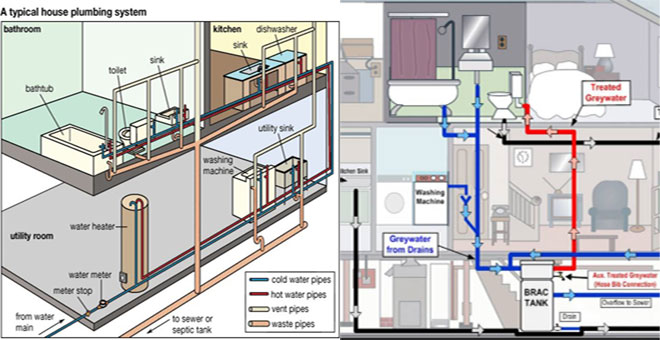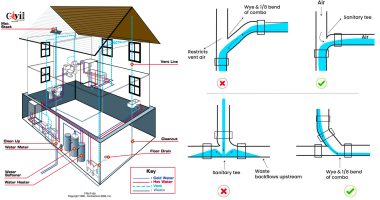Examining Your House's Plumbing System Anatomy
Examining Your House's Plumbing System Anatomy
Blog Article
What are your concepts about Anatomy of a House: Understanding the Components?

Understanding how your home's plumbing system functions is necessary for every single homeowner. From delivering clean water for drinking, food preparation, and bathing to safely eliminating wastewater, a well-kept plumbing system is important for your family's health and comfort. In this extensive overview, we'll explore the complex network that comprises your home's plumbing and deal suggestions on upkeep, upgrades, and managing common concerns.
Intro
Your home's plumbing system is greater than just a network of pipelines; it's a complicated system that ensures you have accessibility to clean water and reliable wastewater removal. Knowing its parts and how they collaborate can aid you stop costly repair services and guarantee every little thing runs smoothly.
Fundamental Components of a Pipes System
Pipes and Tubes
At the heart of your plumbing system are the pipelines and tubing that bring water throughout your home. These can be made of different products such as copper, PVC, or PEX, each with its advantages in terms of longevity and cost-effectiveness.
Fixtures: Sinks, Toilets, Showers, and so on.
Fixtures like sinks, bathrooms, showers, and bathtubs are where water is utilized in your home. Recognizing exactly how these fixtures attach to the plumbing system aids in identifying problems and intending upgrades.
Valves and Shut-off Factors
Valves control the circulation of water in your plumbing system. Shut-off shutoffs are important throughout emergency situations or when you need to make repair services, allowing you to separate parts of the system without interrupting water circulation to the entire residence.
Water System System
Main Water Line
The primary water line connects your home to the local water or a personal well. It's where water enters your home and is dispersed to different components.
Water Meter and Pressure Regulator
The water meter procedures your water use, while a pressure regulator makes sure that water moves at a safe pressure throughout your home's pipes system, stopping damages to pipes and components.
Cold Water vs. Hot Water Lines
Comprehending the difference between cold water lines, which provide water straight from the main, and hot water lines, which carry heated water from the water heater, aids in repairing and planning for upgrades.
Drainage System
Drain Piping and Traps
Drain pipes lug wastewater away from sinks, showers, and bathrooms to the sewage system or septic tank. Traps stop sewer gases from entering your home and also trap debris that might trigger blockages.
Air flow Pipelines
Air flow pipelines permit air into the drain system, protecting against suction that could slow down water drainage and create traps to empty. Appropriate air flow is crucial for maintaining the integrity of your plumbing system.
Value of Correct Drainage
Guaranteeing appropriate water drainage prevents backups and water damage. On a regular basis cleansing drains pipes and maintaining traps can avoid expensive repair work and prolong the life of your pipes system.
Water Heater
Sorts Of Hot Water Heater
Water heaters can be tankless or traditional tank-style. Tankless heating units warm water as needed, while storage tanks save warmed water for prompt use.
Upgrading Your Plumbing System
Reasons for Upgrading
Upgrading to water-efficient fixtures or replacing old pipes can enhance water high quality, minimize water costs, and boost the worth of your home.
Modern Pipes Technologies and Their Advantages
Discover modern technologies like wise leak detectors, water-saving bathrooms, and energy-efficient water heaters that can save money and reduce environmental influence.
Expense Considerations and ROI
Calculate the ahead of time prices versus long-lasting savings when considering pipes upgrades. Numerous upgrades pay for themselves via minimized utility bills and less repair work.
How Water Heaters Attach to the Pipes System
Recognizing just how hot water heater link to both the cold water supply and hot water distribution lines aids in detecting problems like inadequate hot water or leakages.
Maintenance Tips for Water Heaters
Consistently flushing your hot water heater to eliminate sediment, examining the temperature setups, and checking for leakages can prolong its lifespan and boost energy performance.
Typical Pipes Issues
Leaks and Their Reasons
Leakages can happen due to maturing pipes, loose installations, or high water stress. Dealing with leakages promptly avoids water damages and mold development.
Blockages and Obstructions
Clogs in drains pipes and bathrooms are usually triggered by flushing non-flushable products or a buildup of oil and hair. Using drainpipe screens and being mindful of what decreases your drains pipes can avoid obstructions.
Signs of Pipes Troubles to Look For
Low tide pressure, sluggish drains, foul odors, or unusually high water expenses are signs of possible plumbing troubles that ought to be resolved quickly.
Pipes Upkeep Tips
Regular Assessments and Checks
Schedule yearly plumbing assessments to capture issues early. Seek signs of leakages, corrosion, or mineral build-up in faucets and showerheads.
Do It Yourself Maintenance Tasks
Basic jobs like cleaning tap aerators, checking for commode leaks utilizing color tablets, or shielding exposed pipelines in chilly environments can avoid significant plumbing concerns.
When to Call a Professional Plumbing Technician
Know when a plumbing problem calls for specialist proficiency. Trying intricate repair work without appropriate expertise can result in more damages and greater repair service costs.
Tips for Minimizing Water Usage
Basic habits like repairing leakages without delay, taking much shorter showers, and running full tons of washing and recipes can conserve water and lower your energy costs.
Eco-Friendly Pipes Options
Consider sustainable pipes products like bamboo for floor covering, which is durable and eco-friendly, or recycled glass for countertops.
Emergency Readiness
Actions to Take Throughout a Plumbing Emergency
Know where your shut-off valves lie and just how to switch off the water supply in case of a burst pipe or major leakage.
Value of Having Emergency Situation Calls Helpful
Maintain get in touch with info for regional plumbings or emergency services readily available for fast feedback throughout a pipes dilemma.
Environmental Impact and Preservation
Water-Saving Components and Devices
Setting up low-flow taps, showerheads, and commodes can significantly reduce water usage without sacrificing performance.
DIY Emergency Situation Fixes (When Applicable).
Short-lived solutions like utilizing duct tape to patch a dripping pipeline or putting a bucket under a trickling tap can reduce damages till an expert plumbing technician shows up.
Final thought.
Comprehending the anatomy of your home's plumbing system empowers you to keep it properly, conserving money and time on repair work. By complying with regular maintenance regimens and remaining notified regarding modern pipes modern technologies, you can guarantee your plumbing system operates successfully for several years to find.
Understanding Your Home Plumbing System: A Comprehensive Guide
Plumbing System: The Lifeline of Your Home
At its core, the plumbing system is designed to perform two primary functions: bring fresh water into your home and remove wastewater. The system is a network of pipes, fixtures, and other components that transport water and sewage. Residential plumbing systems include potable water supply lines, drain-waste-vent (DWV) systems, and various plumbing fixtures that make water use in daily tasks possible.
Key Components:
Water Supply: This part of your plumbing system brings municipal water into your home, passing through the main water supply line. It s responsible for supplying all water needs, from drinking to bathing.
Drainage System: It carries waste and water away from your home to the sewer or septic system. This system includes all the piping within your home that leads to external sewage or septic systems.
Vent System: An essential yet often overlooked component, the vent system allows sewer gases to escape and lets air into the drainpipes, ensuring water and waste move correctly through the system.
Fixture: More Than Just Taps and Toilets
Plumbing fixtures are the most interactive parts of the plumbing system, including faucets, showers, toilets, and sinks. Each fixture is connected to the plumbing system and plays a role in either the delivery of freshwater or the disposal of waste and wastewater.
Types of Fixtures:
Faucets and Sinks: Used for washing hands, dishes, and other daily water needs. Toilets: Dispose of human waste through the sewage system. Bathtubs and Showers: Provide bathing facilities, requiring both hot and cold water supply. Water Supply: The Source of Life
The water supply system is a critical component, ensuring that potable water is available throughout your home for various uses, including drinking, cooking, and cleaning. This system consists of pipes that distribute water to different parts of the house, controlled by valves to regulate the water flow.
Types of Plumbing: Materials and Methods
Various types of plumbing systems and materials are used in residential settings, each with its advantages and applications. From copper and PVC pipes for water supply to cast iron and ABS for drainage, the choice of materials can impact the longevity and efficiency of your plumbing system.
https://intownplumbingtx.com/articles/home-plumbing-system-guide/

We are very eager about Exploring Your Homes Plumbing Anatomy and I hope you liked my page. Are you aware of anybody else who is truly interested in the subject? Please feel free to share it. Thanks for your time. Come back soon.
Book Appointment Now Report this page